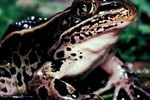
Camouflage is used by most frog species to help evade the eyes of hungry predators. While there are exceptions -- some species have bold rather than cryptic colors -- frogs of the trees, land and water all use camouflage to survive.
Arboreal Frogs
Tree frogs are primarily hunted by birds of prey; unfortunately for frogs, birds often have remarkable vision. Green (Hyla cinerea) and grey (Hyla chrysoscelis) tree frogs of the eastern United States are among the best camouflaged frogs in the world, blending in well with leaves and bark, respectively. A number of tree frogs are also able to change their color to blend in with their surroundings. Barking tree frogs (Hyla gratiosa) change colors frequently, and can be green or grey, with or without dark spots and markings.
Terrestrial Frogs
Some terrestrial species are remarkably camouflaged; the familiar American toad (Bufo americanus) vanishes into the forest leaf litter with little effort. The small size of chorus frogs (Pseudacris sp.) works in concert with their effective camouflage to make them disappear into the grass and weeds of their natural habitat. Many terrestrial frog species will also burrow partially into the substrate, which makes them even harder to see.
Aquatic Frogs
The Suriname toad (Pipa pipa) is perhaps the best camouflaged aquatic species; its brown, tan and grey tones resemble dead leaves in the muddy rainforest pools where they live. These toads remain motionless for long periods, remaining all but invisible to potential prey; insects and fish are rapidly consumed if they drift too close to a well-hidden frog. Some species, like the American bullfrog (Lithobates catesbeiana) and its relatives, spend long periods of time resting on the water's surface. This means the frogs have to camouflage against predators from air and water. To do this, these frogs are counter-shaded; their dorsal surface is dark to avoid the attention of aerial predators, while their ventral surface is light, which blends in the water surface and protects them from fish and crocodilians.
Non-Camouflaged Frogs
The brightly colored poison dart frogs seemingly missed the memo on crypsis. Rather than blending into the habitat, these diurnal frogs appear like multi-colored jewels on the rainforest floor. Armed with incredibly potent poisons, these frogs use the bright colors to warn potential predators. While a number of amphibians possess toxic secretions, typically they only display bold colors like this when their toxins are especially effective.
Best of Both Worlds
Some species are well camouflaged, but have hidden “flash” markings that work to startle potential predators. For example, red-eyed tree frogs (Agalychnis callidryas) are predominately green tree frogs, native to Central and South America. These nocturnal amphibians spend most of their days curled up tightly on leaves, reducing their surface area -- which prevents dehydration -- and presenting a leaf-green surface that camouflages very effectively with the rainforest foliage. This all changes if a predator gets too close; the frog will rapidly spread its legs wide, exposing red, orange and blue markings. At the same time, the frogs open their large, intimidating red eyes; further enhancing the startling effect. Often, the would-be predator is scared away. Grey tree frogs and many other species have orange or chartreuse markings on their rear legs that work in similar fashion. Sometimes, as with grey tree frogs, these warning colors advertise real protective toxins as they do in poison dart frogs. Other times, as with red-eyed tree frogs, the warning is a bluff or represents mimicry of a toxic species.
References
- Rhode Island Vernal Pools: Eastern American Toad (Bufo A. Americanus)
- California Academy of Sciences: Our Pipa Pipa are Breeding!
- Exploratorium: Frogs: The Amazing, Adaptable Frog
- Animal Diversity Web: Dendrobates Auratus
- Animal Diversity Web: Pipa Pipa
- Animal Diversity Web: Agalychnis Callidryas
- Animal Diversity Web: Hyla Gratiosa
- Savanna River Ecology Laboratory: Hyla Chrysoscelis
Photo Credits
-
Jupiterimages/Photos.com/Getty Images


